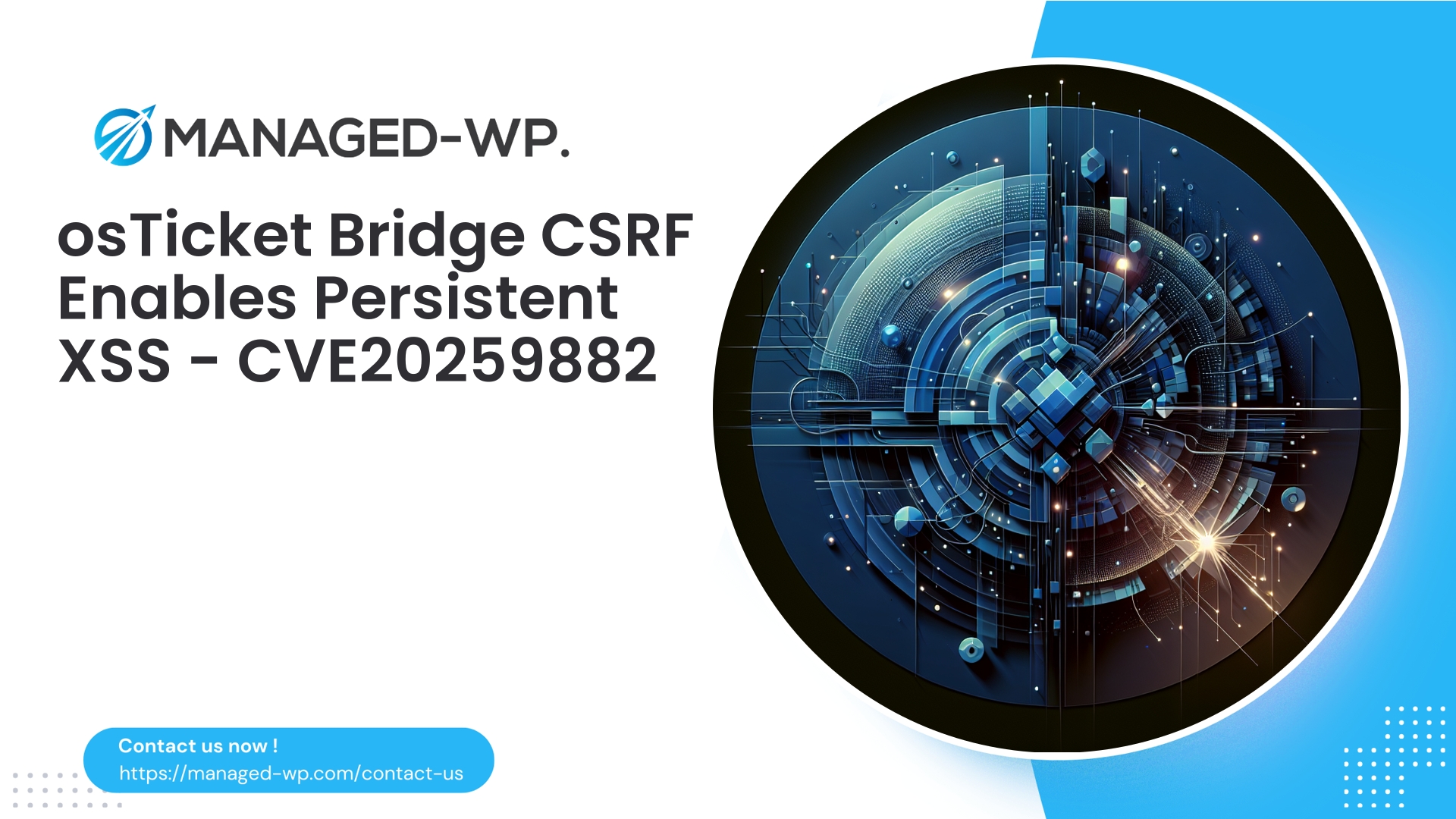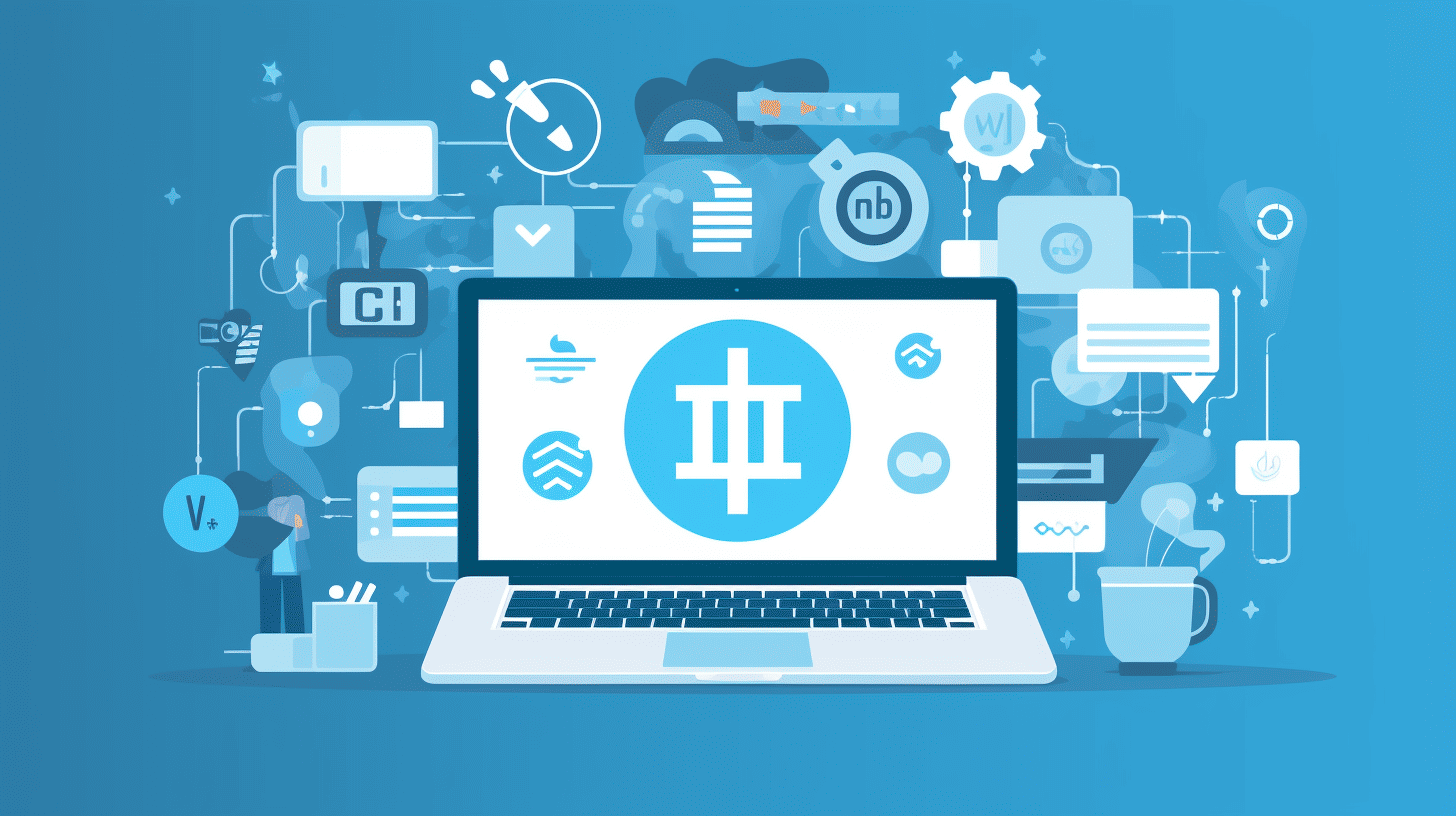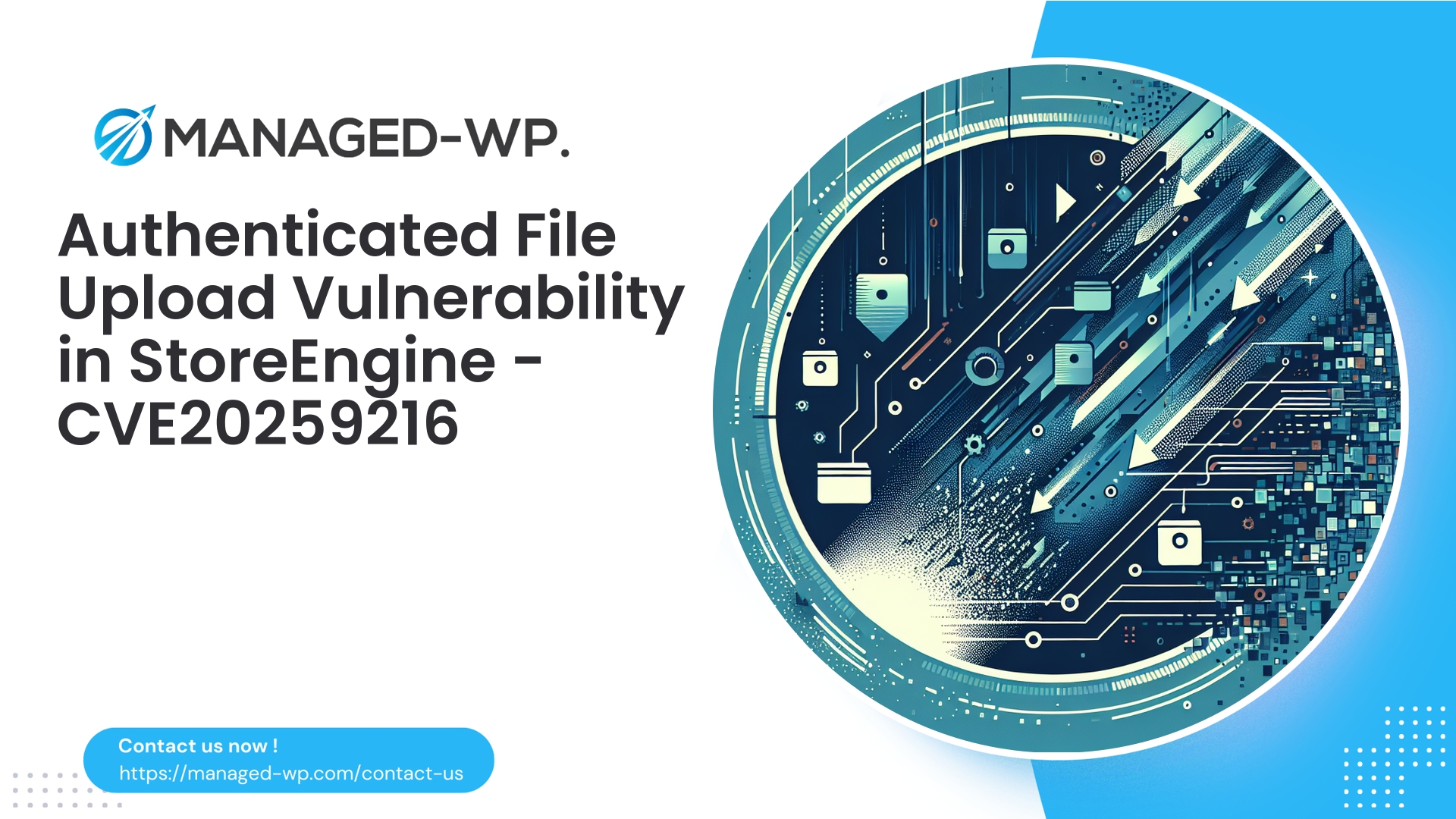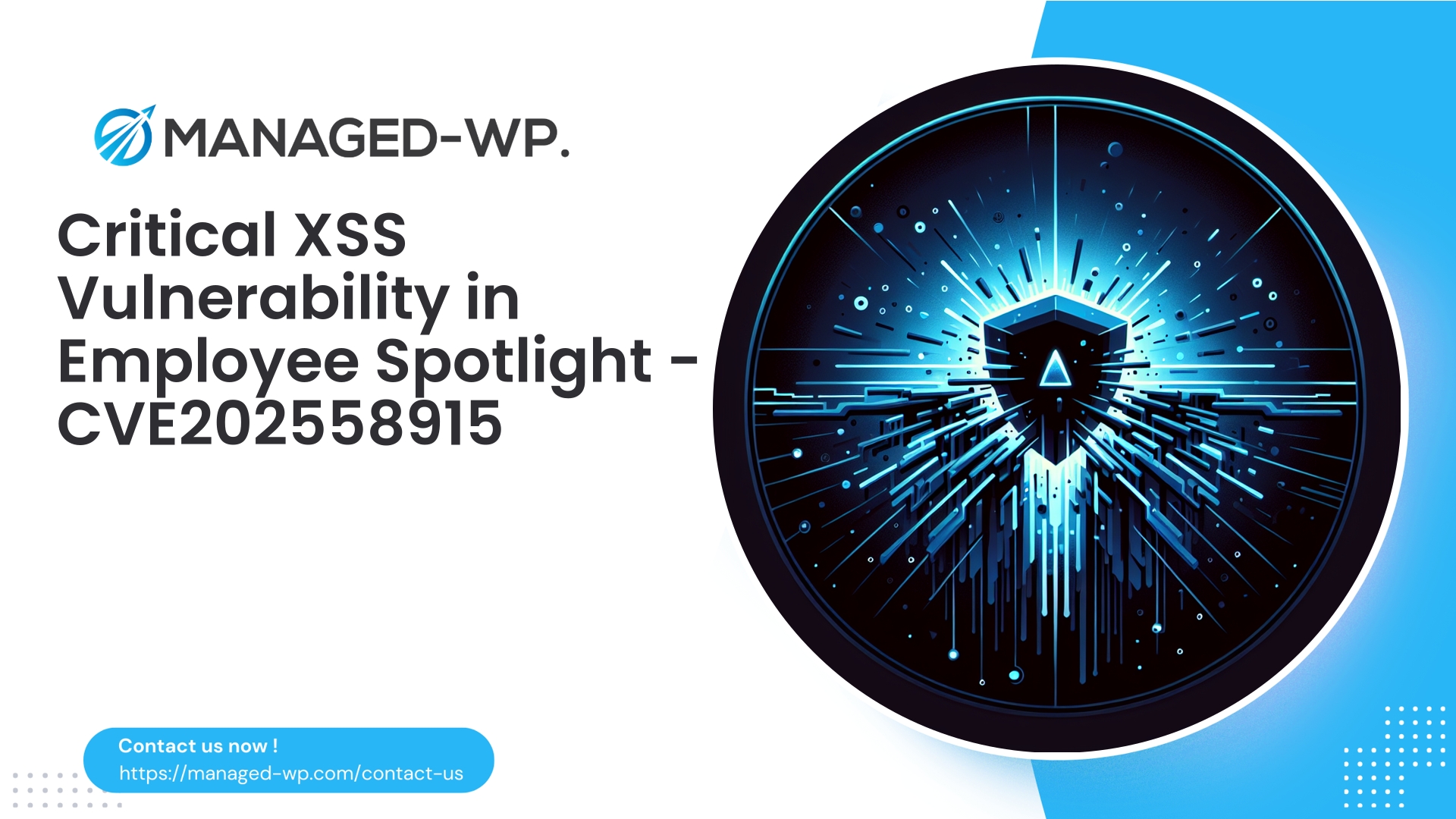| 插件名稱 | osTicket WP Bridge |
|---|---|
| 漏洞類型 | 儲存型XSS |
| CVE編號 | CVE-2025-9882 |
| 緊急 | 中等的 |
| CVE 發布日期 | 2025-09-20 |
| 來源網址 | CVE-2025-9882 |
緊急安全公告:osTicket WP Bridge(≤ 1.9.2)-CSRF 漏洞導致儲存型 XSS 攻擊 (CVE-2025-9882)-WordPress 網站所有者需立即採取的措施
發布日期: 2025年9月20日
嚴重程度: 中(CVSS 7.1)
受影響的插件: osTicket WP Bridge(WordPress 外掛)– 版本 1.9.2 及以下
CVE標識符: CVE-2025-9882
可利用性: 未經身份驗證(無需登入)
補丁狀態: 截至發稿時,尚無官方補丁可供使用。
如果您的 WordPress 安裝使用了 osTicket WP Bridge 插件,請務必立即關注此通知。最近揭露的漏洞允許攻擊者利用跨站請求偽造 (CSRF) 漏洞,在無需任何身份驗證的情況下執行儲存型跨站腳本 (XSS) 攻擊。此漏洞使攻擊者能夠注入持久性惡意腳本,這些腳本會在管理員或網站訪客的瀏覽器中運行,可能導致網站完整性受損、敏感資料被盜以及使用者信任度下降。
作為服務於美國 WordPress 社群的網路安全專家,Managed-WP 對此漏洞進行了全面分析。我們概述了該漏洞的性質、可能的利用場景、檢測策略、即時應對措施以及建議的開發最佳實踐。此外,我們還解釋了我們的託管式 Web 應用程式防火牆 (WAF) 如何提供虛擬補丁,在官方修復程式發布之前保護您的網站。
目錄
- 漏洞概述
- 技術細節
- 潛在攻擊途徑及影響
- 如何檢測漏洞利用
- 立即採取的遏制措施
- 長期開發商建議
- 管理型 WAF 在緩解措施中的作用
- 事件回應工作流程
- 關鍵日誌和資料庫指標
- 優先風險管理
- 使用 Managed-WP 的免費 WAF 方案獲得保護
- 閉幕致詞及其他資源
漏洞概述
osTicket WP Bridge 外掛程式(版本 ≤ 1.9.2)已被發現有嚴重的 CSRF 漏洞,該漏洞會導致儲存型 XSS 攻擊。攻擊者可以誘使受害者的瀏覽器發送精心建構的請求,將惡意 JavaScript 程式碼儲存在您網站的資料庫中。當這些程式碼隨後被渲染時(通常是在 WordPress 管理後台),任意程式碼將在使用者的瀏覽器上下文中執行。這可能導致會話劫持、未經授權的管理操作、惡意軟體部署以及進一步的網路入侵。
由於此漏洞利用無需身份驗證,並且利用了持久腳本,因此攻擊面和風險顯著增加,尤其是在多管理員網站和麵向客戶的入口網站上。
技術細節
- 漏洞類型: 跨站請求偽造 (CSRF) 可實現儲存型跨站腳本 (XSS) 攻擊
- 身份驗證要求: 無;已認證使用者和未認證使用者均可觸發
- 受影響的輸入: 接受使用者內容(工單、訊息、備註)的插件介面
- 根本原因: 缺乏 CSRF 保護(缺少 nonce 驗證),加上輸入清理和輸出轉義不足
- CVSS評分: 7.1(中)-反映出影響較大,但可採取一些緩解措施
簡而言之,攻擊者可以利用缺少的 CSRF 令牌檢查來注入 JavaScript 程式碼,該程式碼會持久存在於 WordPress 管理頁面或公共頁面中顯示的記錄中,從而允許在任何檢視者的瀏覽器上執行任意腳本。
潛在攻擊途徑及影響
主要攻擊場景包括:
- 面向管理員的惡意腳本注入: 攻擊者透過提交精心建構的 CSRF 請求,將 JavaScript 程式碼插入工單訊息或備註中,當網站管理員查看這些內容時,程式碼就會執行。這會導致管理員憑證被盜、權限提升和未經授權的控制。
- 用戶端有效載荷執行: 如果票務資訊或訊息公開顯示,注入的腳本可能會影響訪客,導致重定向、網路釣魚覆蓋或惡意軟體傳播。
- 自動化大規模妥協: 如果沒有身份驗證屏障,攻擊者可以發動大規模注入攻擊,將持久性用戶端漏洞利用程式傳播到多個易受攻擊的網站。
典型後果包括:
- 透過竊取 cookie 或強制操作接管管理員帳戶
- 網站篡改或搜尋引擎優化中毒
- 惡意軟體傳播和未經授權的重定向
- 透過連鎖攻擊竊取資料並進一步提升權限
如何檢測漏洞利用
- 請驗證插件版本: 任何 osTicket WP Bridge 版本 ≤ 1.9.2 都應被視為有漏洞,直到更新為止。
- 監控日誌中的惡意 POST 請求: 檢查 Web 和應用程式日誌,尋找包含腳本標籤或針對插件端點的 JavaScript 事件處理程序的可疑 POST 有效負載。
- 資料庫檢查: 搜尋典型的 XSS 有效載荷標記,例如
<script,錯誤=或票據、訊息和備註欄位中的編碼變體。 - 審計管理介面: 檢查外掛程式管理頁面中是否有異常內容或彈出視窗行為。
- 檢查檔案系統和計劃任務: 偵測未經授權的文件修改或新增的腳本,並檢查排程任務中是否有可疑條目。
- 帳戶活動監控: 留意是否有意外的新管理員帳號、密碼重設或來自未知 IP 位址的登入。
- 使用安全掃描器: 執行全面的惡意軟體和漏洞掃描,以發現利用漏洞的痕跡。
如果發現入侵跡象,立即執行下列事件回應程序。
立即採取的遏制措施
- 備份您的網站: 在進行任何變更之前,請務必對網站文件、資料庫和日誌進行完整備份,以保留取證證據。
- 停用或移除存在漏洞的插件: 在發布並測試出安全性更新之前,請停用 osTicket WP Bridge。
- 限制網站存取: 如果可能,限制公眾訪問或暫時將網站置於維護模式。
- 啟用託管 WP WAF 虛擬補丁: 啟動 WAF 規則,阻止惡意負載和 CSRF 攻擊向量,以防止進一步濫用。
- 重設憑證: 輪換所有管理員密碼、API金鑰和整合令牌。
- 刪除惡意儲存內容: 使用過濾器或手動編輯,從資料庫中清理或清除注入的腳本。
- 檢查檔案系統: 刪除未經授權的文件,並根據可信任來源驗證核心主題和外掛程式的完整性。
- 查看已排程的任務: 識別並刪除可疑的定時任務或鉤子。
- 清除所有快取: 清除應用層、物件層和 CDN 層的緩存,以確保刪除活動有效載荷。
- 加強監測: 啟用增強型日誌記錄並監控異常行為。
對於情況不明或已確認的安全漏洞,請聯絡網路安全專業人員以獲得深入的事件回應支援。
長期開發商建議
- 強制執行 CSRF 保護: 實現 WordPress nonce(
wp_nonce_field()以及驗證函數)在所有狀態改變端點上。 - 輸入驗證和清理: 使用適當的 WordPress 函數(例如)拒絕或清理所有使用者輸入,然後再進行儲存。
sanitize_text_field()或者wp_kses_post(). - 輸出轉義: 使用 WordPress 轉義函數在輸出時轉義所有動態內容(
esc_html(),esc_attr()等等)以防止注入程式碼執行。 - 應用最小權限原則: 需要進行適當的能力檢查(
當前使用者可以())用於敏感操作。 - 實施內容安全策略: 在可行的情況下,配置 CSP 標頭以限制內聯腳本和不安全的 eval 使用。
- 啟用日誌記錄和速率限制: 監控可疑負荷並限制請求速率,以減輕自動化攻擊。
- 徹底測試: 使用單元測試、模糊測試和滲透測試來確保系統能夠抵禦 XSS 和 CSRF 攻擊。
- 建立負責任的資訊揭露程序: 保持暢通的安全通報管道,並及時解決漏洞。
Managed-WP 的 WAF 虛擬修補如何保護您的網站
在官方外掛程式修補程式發布之前,Managed-WP 的託管式 Web 應用程式防火牆 (WAF) 可透過攔截和阻止攻擊嘗試,提供至關重要的臨時保護。我們的 WAF 規則透過以下方式發揮作用:
- 偵測並封鎖包含針對易受攻擊外掛端點的腳本標籤或事件處理程序的 POST 請求。
- 強制執行嚴格的 Origin 和 Referer 標頭驗證,以防止 CSRF 提交。
- 對提交工單點的過度或可疑請求流量進行速率限制。
- 僅允許已知良好的輸入模式,以減少誤報。
- 應用針對 CVE-2025-9882 的客製化虛擬修補規則,有效保護您的網站。
雖然 WAF 保護不是程式碼修復,但它是減少攻擊面和防止在修補程式延遲期間被利用的重要一層。
事件回應檢查表
- 立即採取的行動:
- 備份整個站點,包括檔案、資料庫和日誌。
- 停用 osTicket WP Bridge 外掛。
- 通知相關人員;如有必要,將網站置於維護模式。
- 遏制:
- 啟用針對此漏洞的託管 WP WAF 規則。
- 輪換所有管理員憑證和 API 金鑰。
- 如果懷疑託管環境遭到入侵,請將其隔離。
- 調查:
- 追蹤可疑的 POST 請求和時間戳記。
- 尋找並分析資料庫中儲存的腳本。
- 保留日誌以供法醫檢驗。
- 根除:
- 移除注入的惡意內容或清理危險輸入。
- 刪除未經授權的檔案或惡意軟體。
- 重建或恢復受損的軟體組件。
- 恢復:
- 謹慎恢復服務。
- 修補和驗證後重新啟用插件。
- 確認網站功能完全正常。
- 事件後回顧:
- 記錄根本原因和應對時間表。
- 改進監控和補丁管理。
- 定期安排安全審計和滲透測試。
關鍵日誌和資料庫指標
請根據您的 WordPress 資料庫架構調整這些查詢,並謹慎地以唯讀模式執行:
- 在貼文或選項中尋找可疑的腳本標籤:
SELECT ID, post_title FROM wp_posts WHERE post_content LIKE '%
SELECT option_name FROM wp_options WHERE option_value LIKE '% - 檢查用戶元資料和插件表:
SELECT * FROM wp_usermeta WHERE meta_value LIKE '%document.cookie%' OR meta_value LIKE '% - 分析 Web 伺服器日誌,尋找發送到外掛端點的 POST 請求,這些請求的有效負載可疑且缺少 Referer/Origin 標頭。
- 監控管理員登入訊息,尋找異常 IP 位址或意外的密碼重設事件。
注意:攻擊者可能會使用事件處理程序混淆腳本(錯誤=, onload=)、編碼字元或 base64 編碼內容-務必保持警惕。
風險管理和優先事項
- 運行此外掛程式且有多個管理員或包含公開內容的網站應立即採取行動,因為有更高的安全漏洞利用風險。
- 非活動插件實例仍然構成中等風險-考慮完全移除以減少攻擊面。
- 流量大的網站或電子商務網站必須優先考慮隔離、虛擬修補和監控,以防止影響收入的攻擊。
定期更新插件仍然是長期安全防護的基石。如果供應商延遲發布補丁,請使用 Managed-WP 的虛擬補丁功能,並考慮替換那些不再維護的插件。
使用 Managed-WP 的免費 WAF 計劃保護您的網站 – 立即獲得防護
Managed-WP 提供主動式防火牆解決方案,可立即協助您緩解此漏洞。我們的基礎免費套餐包含託管防火牆規則、惡意軟體掃描以及專門針對 OWASP Top 10 風險優化的保護——所有這些都不限制頻寬,也無需預付費用。
- 在此註冊並啟用保護: https://my.wp-firewall.com/buy/wp-firewall-free-plan/
- 免費方案提供:
- 具備虛擬修補程式功能的託管防火牆,可針對已知漏洞進行修補。
- Web應用程式防火牆經過最佳化,可阻止XSS和CSRF攻擊。
- 惡意軟體掃描和自動可疑有效載荷檢測
- 針對常見的 OWASP Top 10 漏洞的防護
升級後可解鎖高級自動化、主動惡意軟體清除、IP 管理、定期報告和增強型虛擬修補功能——但免費版可提供有效的臨時防禦。
結語和推薦閱讀
- 清點您控制下的所有 WordPress 站點,以識別 osTicket WP Bridge 實例並套用隔離協議。
- 制定積極主動的更新計畫並持續監控,以減少未修補漏洞的風險。
- 透過 WAF 進行虛擬修補是一種強大的臨時工具,但它並不能取代安全編碼和及時更新的必要性。
- 開發人員應遵循安全編碼標準,強制執行適當的身份驗證和驗證,並保持開放的安全報告管道。
如果您需要虛擬修補程式、日誌分析或資料庫清理方面的專家支持,Managed-WP 的安全團隊隨時準備提供協助——迅速採取行動對於最大限度地減少損失至關重要。
保持警惕。定期備份數據,持續監控存取情況,並優先採取縱深防禦策略,以保護您的 WordPress 網站免受不斷演變的威脅。



















